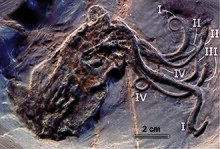Octopodiformes
| Octopodiformes Temporal range: The oldest fossils of
stem-group octopods appeared in the Serpukhovian (late Mississippian ) | |
|---|---|

| |
| Fossil of Proteroctopus from the Middle Jurassic of France, now thought to be a basal vampyropode or vampyromorph | |
| Scientific classification | |
| Domain: | Eukaryota |
| Kingdom: | Animalia |
| Phylum: | Mollusca |
| Class: | Cephalopoda |
| Clade: | Vampyropoda
|
| Superorder: | Octopodiformes Fuchs, Von Boletzky, & Tischlinger, 2010[2] |
| Subgroups | |
| Synonyms | |
Octopodiformes is a superorder of the subclass
total group (all cephalopods closer to octopods than to true squid). Another term is Octobranchia, referring to cephalopods without prominent tentacles.[4]
It is considered one of the two extant groups of the Neocoleoidea.[2]
Syllipsimopodi has a combination of squid-like features (like 10 arms) and octopod-like features (like biserial suckers and a simplified internal shell).[4]
Classification
- Class Cephalopoda
- Subclass Nautiloidea: nautilus
- Subclass †Ammonoidea: ammonites
- Subclass Coleoidea
- Superorder Decapodiformes: squid, cuttlefish
- Clade Vampyropoda
- Genus †Syllipsimopodi[4]
- Genus †Proteroctopus
- Superorder Octopodiformes / Octobranchia
- Family †Trachyteuthididae (incertae sedis)
- Order Vampyromorphida: vampire squid
- Clade: Muensterelloidea
- Family: †Muensterellidae
- Family: †Patelloctopodidae
- Order Octopoda
- Genus †Keuppia (incertae sedis)
- Genus †Palaeoctopus (incertae sedis)
- Genus †Paleocirroteuthis (incertae sedis)
- Genus †Proteroctopus (incertae sedis)
- Genus †Styletoctopus (incertae sedis)
- Suborder Cirrina: finned deep-sea octopus
- Family Opisthoteuthidae: umbrella octopus
- Family Cirroteuthidae
- Family Stauroteuthidae
- Family
- Suborder Incirrina
- Superfamily Octopodoidea[7]
- Family Amphitretidae[8]
- subfamily Amphitretinae: telescope octopus
- subfamily Bolitaeninae: gelatinous octopus
- subfamily Vitreledonellinae
- Family Bathypolypodidae
- Family Eledonidae
- Family Enteroctopodidae
- Family Megaleledonidae
- Family Bolitaenidae: gelatinous octopus
- Family Octopodidae: benthic octopus
- Family Amphitretidae[8]
- Superfamily Argonautoidea
- Family Alloposidae: seven-arm octopus
- Family Argonautidae: argonauts
- Family Ocythoidae: tuberculate pelagic octopus
- Family Tremoctopodidae: blanket octopus
- Superfamily Octopodoidea[7]
- Family †
- Subclass
References
- ^ PMID 31372519.
- ^ .
- ^ a b Young, Richard E.; Vecchione, Michael; Fuchs, Dirk (May 3, 2010). "Octopodiformes Berthold and Engeser, 1987. Vampire Squid and Octopods". Tree of Life Web Project. Retrieved Jun 2, 2010.
- ^ S2CID 247317831.
- PMID 38062003.
- PMID 38086818.
- ^ "WoRMS - World Register of Marine Species - Octopodoidea d'Orbigny, 1840". www.marinespecies.org. Retrieved 2023-04-20.
- ^ "WoRMS - World Register of Marine Species - Amphitretidae Hoyle, 1886". www.marinespecies.org. Retrieved 2023-04-20.
External links
